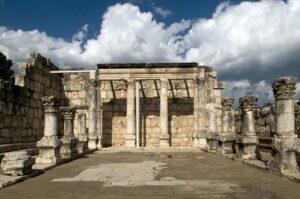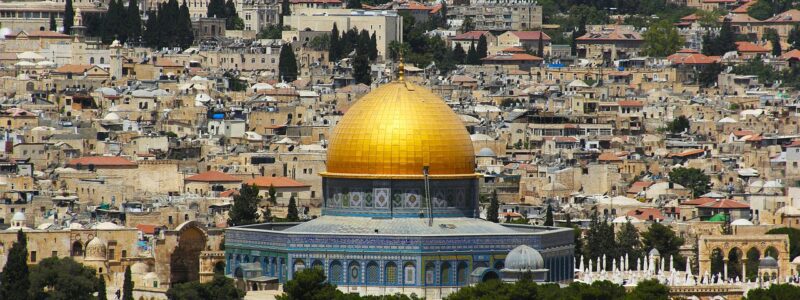Capernaum Synagogue
The Capernaum Synagogue

By Eddie Gerald – This file has been provided by UNESCO (unesco.org) as part of a GLAM-Wiki partnership., CC BY-SA 3.0-igo, https://commons.wikimedia.org/w/index.php?curid=37387366
Finding an ancient synagogue in the Holy Land would seem to be unimportant – trival even. We know from Scripture as well as from ancient records that Jews would congregate in a synagogue on the Sabbath. There were multiple reasons for meeting in a synagogue, perhaps the most important of which would be to worship God and keep the Sabbath holy – set apart as being different from other days.
Synagogues are not specifically mentioned in the Old Testament but are thought to have started after return from the Jewish Babylonian exile as a place for men to discuss the law. The Jews were punished for seventy years in a foreign land for not taking their religious identity seriously. They would not make the same mistake twice and became serious in the study and application of the Mosaic law in their lives. In a short time, multiple synagogues were erected throughout Israel and then later throughout the world during the time of the diaspora.
The synagogue was usually erected in the shape of a rectangle and built so that a worshiper would face Jerusalem after entering the structure. People would stand in the middle of the building with men and women separated by a partition. A platform would be erected in front of the building where a lectern would stand from which would be read the law and the prophets.
A “bima” or platform would also be near the center of the building representing the Holy Place, while a chest that contained the sacred scrolls would rest near the rear wall covered by a veil representing the Holy of Holies.
A board of elders would manage the synagogue, along with special offices such as a ruler of the synagogue who directed worship, and one or more attendants (chazan) who would bring a roll of Scripture to the reader, and then replace it in the sacred repository when done.
They would also inflict corporal punishment on persons sentenced by the authorities for serious religious infractions, taught the youth of the congregation as required by the Shema (Deut. 6:5-9), open and close the synagogue, etc. There was also a dispenser of alms to the poor, and several wealthy men who represented the congregation at every service.
The synagogue service would consist of reading the Shema, prayer, reading the law and the prophets, discourse from anybody who wanted to speak (Acts 13:15), and the benediction to close the meeting.
The synagogues throughout the known world had significance for Christians too, as they were often used by Paul on his missionary journeys. When entering a new town, Paul would first go to the synagogues and speak with the congregations concerning Christ – the Messiah. Usually, his message was not accepted, and he was forced from their midst.
Capernaum
The English name is thought to represent the Hebrew “village of Nahum” (kfar Nahum) and is located on the northern shore of the Sea of Galilee not far from Bethsaida. Capernaum became known as “His [Christ’s] own city” (Matthew 9:1) where Christ performed multiple miracles and visited the synagogue on multiple occasions.
The Capernaum synagogue achieved especially important to Christians as it was the place where Christ taught the New Covenant; of course, there was little acceptance of his teaching as they had little insight into the meaning of his message.
The ruins of Capernaum were known in Arabic as Tel Hum and identified in 1838 by Eduard Robinson as Capernaum. Several decades later, British Captain Charles William Wilson identified the remains of an old synagogue in the town, and in 1894 a Franciscan Friar named Giuseppe Baldi was able to obtain much of the land from the Bedouins and protected the area from vandalism.
Further excavations began in 1905 resulting in the discovery of the synagogue which was later excavated in 1968 with the financial assistance of the Italian government.
The synagogue was built from white limestone and extensively ornamented. It was a two-story structure built in the third century AD that is built upon the same site s the original first-century synagogue visited by Jesus. It was apparently the most beautiful building in the city and visited by the faithful from distant cities.
Importance of the Capernaum Synagogue
Christ delivered many messages to the Capernaum congregations while he stayed probably in Peter’s house nearby. Scripture reports that people were amazed at Christ’s teaching because he spoke as one who had authority and not like the teachers of the law who had little actual insight.
It was at the synagogue that Christ taught he was the true bread of life, likely where he raised Jairus’ daughter and taught the disciples about being childlike bringing a child into the midst of them (Mark 9:33-37). Christ also spoke with Peter about paying the Temple tax by catching a fish to pay for it (Matthew 17:24-27).
It was also in the synagogue that Christ met a man who was possessed by an evil spirit. The spirit immediately knew the true identity of Christ and cried out, “What do you want with us, Jesus of Nazareth? Have you come to destroy us? I know who you are – the Holy One of God!”
Christ immediately silenced the spirit and ordered it to come out of the man. Scripture reports people being astounded at what happened – that he could even give orders to evil spirits and they obey him (Luke 4:31-37).
While the evil spirit obeyed Christ, the people did not. Despite all the miraculous things they witness and the insightful, authoritative teachings of Christ, they refused to recognize him as the Messiah. Because of this, Christ stated,
And you, Capernaum, will you be lifted up to the skies! No, you will go down to the depths. If the miracles that were performed in you had been performed in Sodom, it would have remained to this day. But I tell you that it will be more bearable for Sodom on the day of judgment than for you. (Matthew 11:23-24)
The History of Capernaum and its Synagogue
Capernaum was originally a fishing village established on the shorts of the Sea of Galilee which was continuously inhabited from the first century BC to the 13th century AD. It was a poor village with the citizens apparently unable to fund the building of a synagogue. It was a Roman Centurion who actually funded the building (Luke 7:5) for the people. Likely this was a token of good faith so that the people would remain calm and view the Roman occupiers with some affection.
Records indicate the village was predominantly Christian by the fourth century AD and Rabbinic texts from that time document some tension between the Christian and Jewish communities. What is known is that sometime during the Persian invasion of 614 and the Byzantine occupation of 629 both the synagogue and a local church were destroyed.
After these conquests by foreign invaders, the village moved east establishing a community including a local church dedicated to St. John Theologus which existed until the mid-10th century. There was an earthquake in 746 which destroyed much of the town from which it never recovered.
The area was visited by Christian Crusaders in the 13th century but was not occupied due to the city being difficult to defend. One visitor noted it was all but abandoned, reporting that,
the once renowned town of Capernaum is at present just despicable. It numbers only seven houses of poor fishermen.
The village remained all but forgotten until the Franciscans built on the land in the 19th century. They raised a fence to protect the site against vandals and planted palms and eucalyptus trees from Australia to create an oasis for pilgrims to visit the area. Most of the early excavations (1905-1926) and restorations were performed by this religious order.
The site itself is now a tourist attraction where the ruined synagogue and church standing close to each other near the shoreline, with ruins of 1st to 6th-century houses in between. Carved stones which belonged to the synagogue (including one with the Star of David) are also visible.
Summary
The historicity of Scripture has been a subject of intense discussion for many years. Many liberal authorities have assumed the Scriptures to be largely fictional, written centuries after the fact by authors not at all familiar with the historical events.
Archaeology has been able to affirm the historicity of many of the events, places, and people recorded in Scripture adding further credence to the story of Christianity.
The gradual unfolding of these archaeological findings portrays a landscape consistent with Scripture and helps readers secure the context in which they occurred.
References
Image: By Eddie Gerald – This file has been provided by UNESCO (unesco.org) as part of a GLAM-Wiki partnership., CC BY-SA 3.0-igo, https://commons.wikimedia.org/w/index.php?curid=37387366




